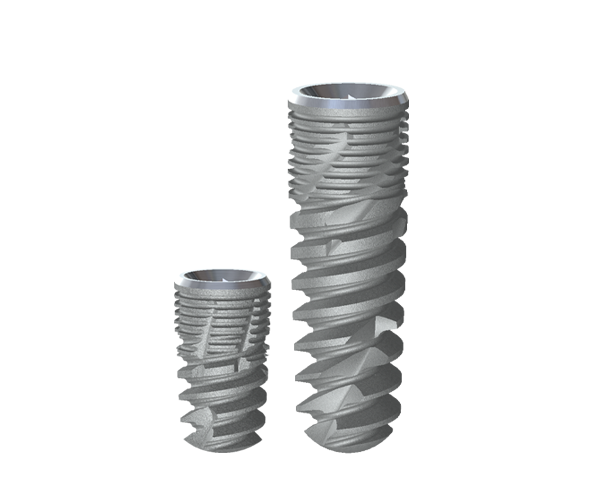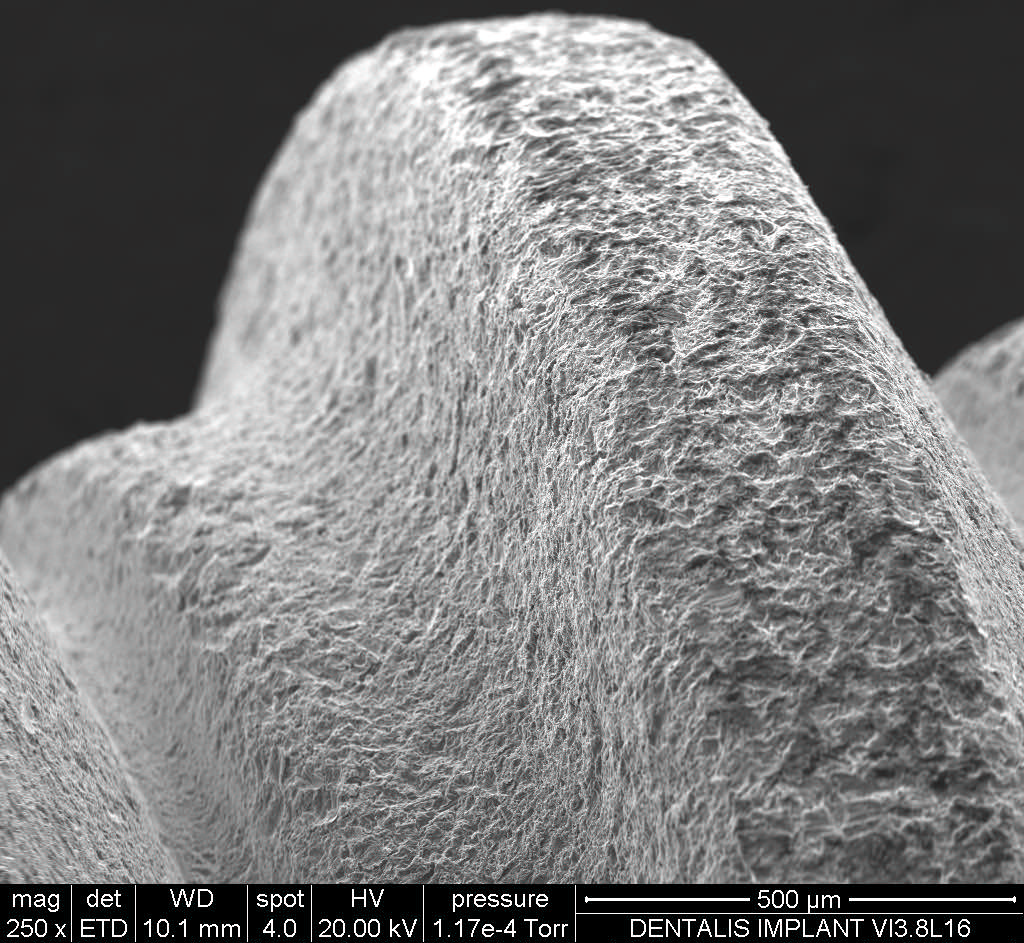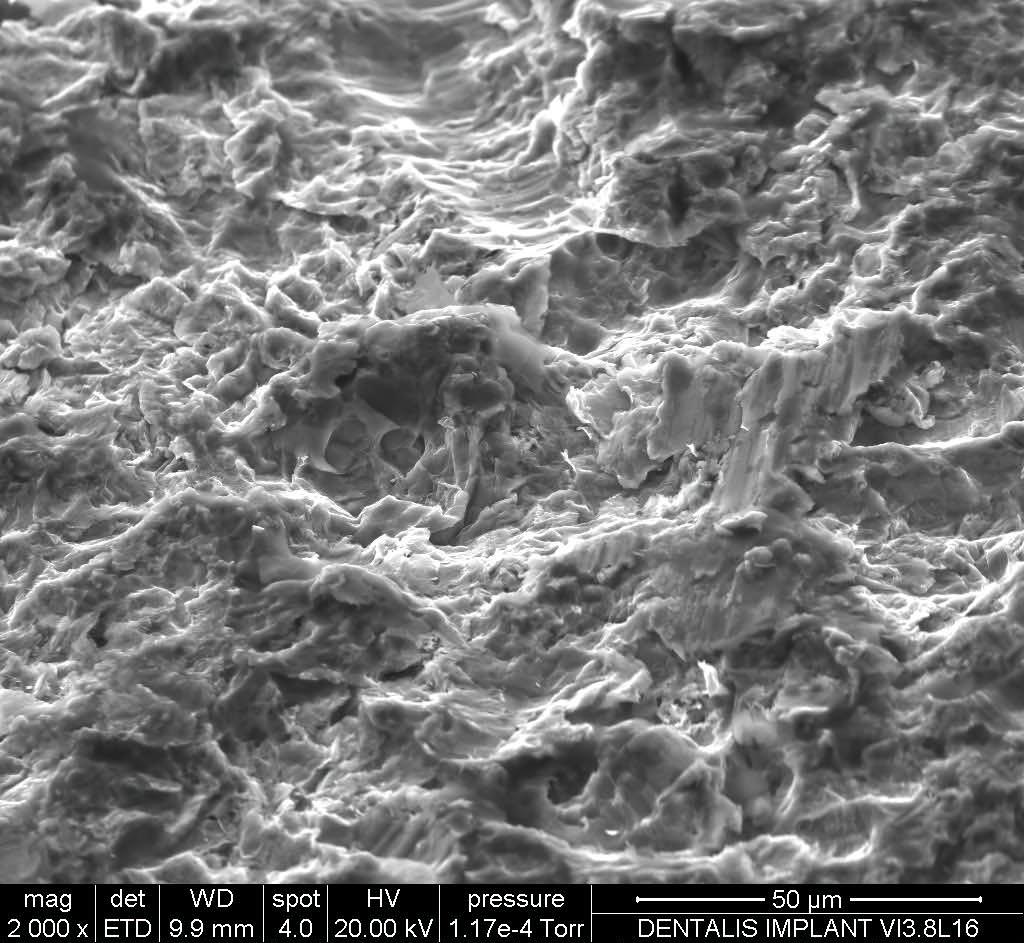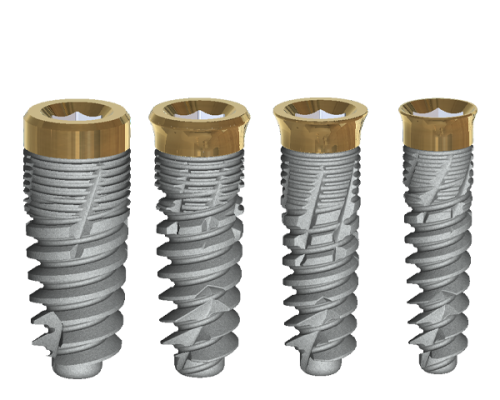Versatile Implant
The combination of innovative surface technology with
344% stronger bone reduces marginal bone loss and
provides for
a higher BIC%, decreasing the risk of
peri-implant disease.
The enhanced deep thread simplifies the insertion and
allows for high primary stability.
Versatile Implant
The combination of innovative surface technology with 344% stronger bone reduces marginal bone loss and provides for a higher BIC%, decreasing the risk of
peri-implant disease.
The enhanced deep thread
simplifies the insertion and
allows for high primary
stability.
Versatile Implant
The combination of innovative surface technology with 344% stronger bone reduces marginal bone loss and provides for
a higher BIC%, decreasing the risk of peri-implant disease.
The enhanced deep thread
simplifies the insertion and
allows for high primary stability.

Versatile Implant, also known as VI, refers to dental implants designed to fit a wide clinical range of bone types, places, and augmentations. The VI body is designed with a narrow, cone-shaped core, with a standard, cylindrical outer thread diameter; the core is more tapered, in order to promote bone condensation. VI design typically features vertical and horizontal threading with dual spiral channels, microthreads, platform switching, and a domed apex. These features facilitate the self-tapping mechanism and enhance the immediate stability of VI products. Additionally, the new VI offers horizontal grooves and grooved threading.
Advantages of VI technology include sharp threads and spiral deepening from cervical to apical region, and improved cutting ability, with better bone to implant contact for better primary stability. The platform switching mechanism enables seamless adaptation of the gingival tissues to the support system and prevents cervical bone reabsorption. Grooved threads enhance bone stabilization during primary stabilization and increase the amount of bone to implant contact, thereby enhancing osseointegration. The presence of two spiral channel, self-tapping cutting threads facilitates implant placement and enhance primary stability.
The Versatile implant offer conical internal hex connection with 45° central hole.

The platform switching mechanism enables seamless adaptation of the gingival tissues to the support system and prevents cervical bone reabsorption

Horizontal grooves produced by micro-machining impedes epithelial down growth on titanium implants.

Micro threads provide enhanced initial stability and increases contact area to crestal bone, which will enhance osseointegration at the crestal bone level.

Grooved threads enhance bone stabilization during primary stabilization and increase the amount of bone to implant contact, thereby enhancing osseointegration.

The presence of two spiral channel, self-tapping cutting threads facilitates implant placement and enhance primary stability

Sharp threads and spiral deepening from cervical to apical region, and improved cutting ability, with better bone to implant contact for better primary stability
Dentalis Surface:
Surface roughness is achieved from “grit-blasting,” using a unique combination of the HA particles (soluble) with different sizes of grains. This process creates optimal structural roughness on the surface the surface, and enables the incorporation of biocompatible particles (such as HA and TCP).



Roughness is measured with an average roughness (Ra), while the most commonly used parameter for describing roughness is calculated in microns. The rough surfaces produced by grit-blasting have irregular geometries with Ra value of 3.3 μm, which is considered optimal for the osseointegration process.

Raw Material:
All Dentalis implants are made of Ti 6Al-4V ELI that is a higher-purity (“extra-low interstitial”) version of Ti 6Al-4V, with lower specified limits on iron and the interstitial elements C and O. It is an alpha + beta alloy .Ti 6Al-4V ELI may be considered in any biomedical application, particularly for implantable components, because of its biocompatibility, good fatigue strength, and low modulus. Ti 6Al-4V ELI has been the material of choice due to its excellent biocompatibility. The ELI grade has superior damage tolerance (fracture toughness, fatigue crack growth rate) and better mechanical properties compared to standard grade Ti 6Al-4V.
Implant Range:
Recommendation :
To reduce the pressure in the bone around the implant neck:
Bone Type D1 use the last drill up to 1/3 depth.
Bone Type D2-3 use the last drill to the depth of the cortex.
Bone Type D4 use the one before last drill desirable to the depth
of the cortex For example: Implant diameter 3.25Ø in soft bone (D4)
use the 2.8 Ø drill as a final drill just for the cortex.
Procedures recommended by DENTALIS cannot replace the judgment and professional experience of the surgeon.
| Drill Speed (RPM) | 900-1200 | 900-1200 | 800-1000 | 500-700 | 400-700 |
|---|---|---|---|---|---|
| Drill Diameter (mm) | ∅ 1.8 | ∅ 2 | ∅ 2.5 | ∅ 2.8 | ∅ 3.2 |

Recommendation :
To reduce the pressure in the bone around the implant neck:
Bone Type D1 use the last drill up to 1/3 depth.
Bone Type D2-3 use the last drill to the depth of the cortex.
Bone Type D4 use the one before last drill desirable to the depth
of the cortex For example: Implant diameter 3.75Ø in soft bone
(D4) use the 3.2 Ø drill as a final drill just for the cortex.
Procedures recommended by DENTALIS cannot replace the judgment and professional experience of the surgeon.
| Drill Speed (RPM) | 900-1200 | 900-1200 | 800-1000 | 500-700 | 400-700 | 400-600 |
|---|---|---|---|---|---|---|
| Drill Diameter (mm) | ∅ 1.8 | ∅ 2 | ∅ 2.5 | ∅ 2.8 | ∅ 3.2 | ∅ 3.6 |

Recommendation :
To reduce the pressure in the bone around the implant neck:
Bone Type D1 use the last drill up to 1/3 depth.
Bone Type D2-3 use the last drill to the depth of the cortex.
Bone Type D4 use the one before last drill desirable to the
depth of the cortex For example: Implant diameter 3.75Ø
in soft bone (D4) use the 3.2 Ø drill as a final drill just for the cortex.
Procedures recommended by DENTALIS cannot replace the judgment and professional experience of the surgeon
| Drill Speed (RPM) | 900-1200 | 900-1200 | 800-1000 | 500-700 | 400-700 | 400-600 | 400-600 |
|---|---|---|---|---|---|---|---|
| Drill Diameter (mm) | ∅ 1.8 | ∅ 2 | ∅ 2.5 | ∅ 2.8 | ∅ 3.2 | ∅ 3.6 | ∅ 4.1 |

Recommendation :
To reduce the pressure in the bone around the implant neck:
Bone Type D1 use the last drill up to 1/3 depth.
Bone Type D2-3 use the last drill to the depth of the cortex.
Bone Type D4 use the one before last drill desirable to the
depth of the cortex For example: Implant diameter 4.7Ø
in soft bone (D4) use the 4.1 Ø drill as a final drill just for the cortex.
Procedures recommended by DENTALIS cannot replace the judgment and professional experience of the surgeon.
| Drill Speed (RPM) | 900-1200 | 900-1200 | 800-1000 | 500-700 | 400-700 | 400-600 | 400-600 | 300-500 |
|---|---|---|---|---|---|---|---|---|
| Drill Diameter (mm) | ∅ 1.8 | ∅ 2 | ∅ 2.5 | ∅ 2.8 | ∅ 3.2 | ∅ 3.6 | ∅ 4.1 | ∅ 4.6 |

Recommendation :
To reduce the pressure in the bone around the implant neck:
Bone Type D1 use the last drill up to 1/3 depth.
Bone Type D2-3 use the last drill to the depth of the cortex.
Bone Type D4 use the one before last drill desirable to the
depth of the cortex For example: Implant diameter 5.0Ø in
soft bone (D4) use the 4.6 Ø drill as a final drill just for the cortex.
Procedures recommended by DENTALIS cannot replace the judgment and professional experience of the surgeon.
| Drill Speed (RPM) | 900-1200 | 900-1200 | 800-1000 | 500-700 | 400-700 | 400-600 | 400-600 | 300-500 |
|---|---|---|---|---|---|---|---|---|
| Drill Diameter (mm) | ∅ 1.8 | ∅ 2 | ∅ 2.5 | ∅ 2.8 | ∅ 3.2 | ∅ 3.6 | ∅ 4.1 | ∅ 4.6 |

Procedures recommended by DENTALIS cannot replace the judgment and professional experience of the surgeon.
Stay Safe. Wear a Mask!
For over two decades, Dentalis has led implant dentistry into a new era of attainability and aesthetics.
The pink tissue versatile implant neck combines superior gingival aesthetics and high primary stability, improved placement,
and temporization, which is particularly beneficial in
aesthetically demanding cases.
REFERENCES:
1.Bittner N, Schulze-Späte U, Cleber S, Da Silva J, Kim D, Tarnow D, Ishikawa-Nagai S, Gil M. Comparison of Peri-implant Soft Tissue Color with the Use of Pink-Neck vs Gray Implants and Abutments Based on Soft Tissue Thickness:
A 6-Month Follow-up Study. Int J Prosthodont. 2020Jan/Feb;33(1):29-38.
2. Gil M, Ishikawa-Nagai S, Elani H, Da Silva J, Kim D, Tarnow D, Schulze-Späte U, Cleber S, Bittner N. Comparison of the Color Appearance of Peri-implant Soft Tissue with Natural Gingiva Using Anodized Pink-Neck Implants and Pink Abutments: A Prospective Clinical Trial. Int J Oral Maxillofac Implants. 2019 May/June;34(3):752–758.
3.Gil M, Ishikawa-Nagai S, Elani H. A prospective clinical trial to assess the optical efficacy of pink neck implants and pink abutments on soft tissue aesthetics. J Esthet Restor Dent. 2017;29(6):1-7.38.
For over two decades, Dentalis has led implant dentistry into a new era of attainability and aesthetics.
The pink tissue versatile implant neck combines superior gingival aesthetics and high primary stability, improved placement, and temporization, which is particularly beneficial in aesthetically demanding cases.

REFERENCES:
1.Bittner N, Schulze-Späte U, Cleber S, Da Silva J, Kim D, Tarnow D, Ishikawa-Nagai S, Gil M. Comparison of Peri-implant Soft Tissue Color with the Use of Pink-Neck vs Gray Implants and Abutments Based on Soft Tissue Thickness:
A 6-Month Follow-up Study. Int J Prosthodont. 2020Jan/Feb;33(1):29-38.
2. Gil M, Ishikawa-Nagai S, Elani H, Da Silva J, Kim D, Tarnow D, Schulze-Späte U, Cleber S, Bittner N. Comparison of the Color Appearance of Peri-implant Soft Tissue with Natural Gingiva Using Anodized Pink-Neck Implants and Pink Abutments: A Prospective Clinical Trial. Int J Oral Maxillofac Implants. 2019 May/June;34(3):752–758.
3.Gil M, Ishikawa-Nagai S, Elani H. A prospective clinical trial to assess the optical efficacy of pink neck implants and pink abutments on soft tissue aesthetics. J Esthet Restor Dent. 2017;29(6):1-7.38.
Dentalis coatings showed higher anti-bacterial activity and minimized bacterial adhesion without compromising the biocompatibility of the titanium surface.
These findings are clinically applicable as the coatings can minimize detrimental colonization of P. gingivalis and other pathogens on implant surfaces.
This is the first dental implant to combine the concept of tissue-level implants with an anti-bacterial coating on the implant neck, preventing peri-implant disease and
providing predictable results you can trust.
This could potentially decrease the risk of peri-implant disease.

Dentalis coatings showed higher anti-bacterial activity and minimized bacterial adhesion without compromising the biocompatibility of the titanium surface.
These findings are clinically applicable as the coatings can minimize detrimental colonization of P. gingivalis and other pathogens on implant surfaces.
This is the first dental implant to combine the concept of tissue-level implants with an anti-bacterial coating on the implant neck, preventing peri-implant disease and
providing predictable results you can trust.
This could potentially decrease the risk of peri-implant disease.

Dentalis coatings showed higher anti-bacterial activity and minimized bacterial adhesion without compromising the biocompatibility of the titanium surface.
These findings are clinically applicable as the coatings can minimize detrimental colonization of P. gingivalis and other pathogens on implant surfaces.
This is the first dental implant to combine the concept of tissue-level implants with an anti-bacterial coating on the implant neck, preventing peri-implant disease and
providing predictable results you can trust.
This could potentially decrease the risk of peri-implant disease.

